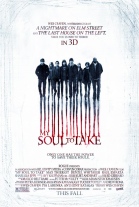My Soul to Take
|  Because Wes Craven’s My Soul to Take is his first effort as both writer and director since 1994’s underappreciated meta-horror experiment New Nightmare, it will likely be seen as even more of a disappointment than it actually is. The fact that the film has been sitting on a shelf for more than a year should tell you something about its overall quality, as should its subsequent retrofitting for 3-D, which allows the studio to charge more per ticket and also employ a misleading advertising come-on about it’s being Craven’s first venture into three-dimensional imagery (granted, it is the first Craven-directed film to be shown in 3-D, but the advertising implies that it was part of his overall vision, rather than a last-minute add-on designed to pull in more dollars for a film that is all but destined to sink at the box office). Because Wes Craven’s My Soul to Take is his first effort as both writer and director since 1994’s underappreciated meta-horror experiment New Nightmare, it will likely be seen as even more of a disappointment than it actually is. The fact that the film has been sitting on a shelf for more than a year should tell you something about its overall quality, as should its subsequent retrofitting for 3-D, which allows the studio to charge more per ticket and also employ a misleading advertising come-on about it’s being Craven’s first venture into three-dimensional imagery (granted, it is the first Craven-directed film to be shown in 3-D, but the advertising implies that it was part of his overall vision, rather than a last-minute add-on designed to pull in more dollars for a film that is all but destined to sink at the box office).The story takes place in the small, picturesque Connecticut town of Riverton and concerns a group of local teenagers who were all born prematurely on the same day 16 years ago when a serial killer known as the Riverton Ripper was supposedly killed in an ambulance crash after being captured by police. The film’s opening sequence depicts the Ripper, who is an otherwise unassuming suburban husband and father who is clearly either suffering from a significant bout of split personalities or is possessed by an evil spirit. Craven works these opening moments into an abrupt, but worthwhile frenzy, thus promising later payoffs that never quite materialize. We then cut to the present tense and are introduced to the seven disparate teenagers--the “Riverton Seven,” as they are known--who were all born on the day the Ripper was killed. Each year they enact a ritual in the woods that is meant to ward off the Ripper’s spirit, which is said to rise from the river. How seriously the kids take this ritual is questionable; even though there is clearly social pressure to be present and accounted for, few seem to take it very seriously, especially Brandon (Nick Lashaway), the football bully who runs the show. Other members of the group include Penelope (Zena Grey), an ardent Christian who says things like, “When it gets too hot, turn on the prayer conditioning,” and Brittany (Paulina Olszynski), the school’s cold-hearted hottie. Brittany works as a lackey for Fang (Emily Meade), the school’s most feared girl who victimizes the rest of the student body via a kind of high school mafia that she operates from the girls’ restroom. At the bottom of the ladder we have Bug (Max Thieriot), an almost pathologically introverted teen who has a hopeless crush on Brittany, and his more gregarious, but still socially outcast best friend Alex (John Magaro). Bug and Alex’s consistent feminization all but assures us that at least one of them will be the proverbial “Final Girl,” although Bug has more than enough weird traits (including moments when he seems to become someone else) to suggest that something may be amiss. They night after their annual ritual is broken up by the police before completion, one of the Riverton Seven (Jeremy Chu) is brutally murdered by a hulking man with long hair, and the following day the rest start getting knocked off one by one. Could it be that the Ripper never actually died and has been hiding, ala Jason Voorhees, in the woods for the past decade and a half while waiting for his moment of revenge? Or has the Ripper’s spirit invaded another body to carry on its bloody work? Or, is it possible that one of the teenagers is a closet psychopath using the Ripper’s legacy as a cover for murder? Given that Craven’s most significant contribution to the horror genre was the explicit mixing of the slasher film with supernatural horror in A Nightmare on Elm Street (1984), it isn’t too hard to guess where all of this is heading, although the film is most shocking for how ridiculously long it takes to get there. Craven seems to be under the impression that if he draws it all out long enough, the ending will carry additional weight, but the film’s convoluted and labored logic and lack of sympathetic characters ultimately renders the effort moot. While it manages to generate some good atmosphere in its opening moments, My Soul to Take is ultimately disappointing in the way it drags out its narrative to little effect, pummeling us with generally unlikeable characters and substituting cheap revelations and sometimes incoherent action for anything resembling the kind of innovation and verve that is the hallmark of Craven’s best work. Perhaps his having spent most of the past decade presiding over increasingly lousy remakes of his early horror films has sapped him of any real creative energy. Copyright ©2010 James Kendrick Thoughts? E-mail James Kendrick All images copyright © Rogue Pictures |
Overall Rating: 
 (2)
(2)


